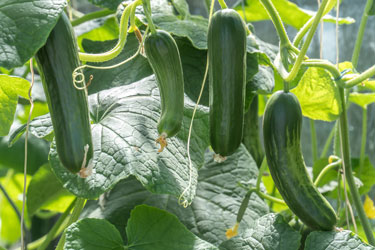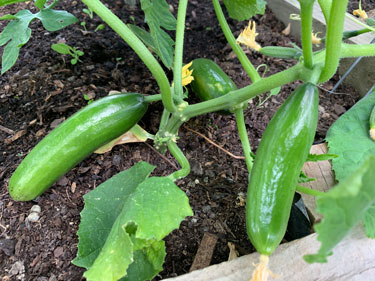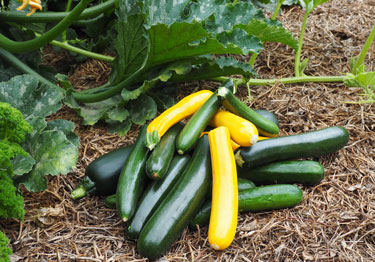A cucumber a day
Munching on a cucumber which is 95% water, is a tasty way to stay well-hydrated in summer, aiding weight loss with a good measure of fibre, vitamins and minerals without the calories.
Sowing a handful of seed every few weeks from November till January will avoid the mid-summer glut and keep you proudly crunching through your home-grown cucumbers until the first autumn frost. Gardeners’ partial to a pickle or a sweet, tasty relish can grow as many baby cucumbers (aka gherkins) as they have space for.
Cucumbers belong to the plant family, cucurbitaceae, along with melons, zucchini, pumpkins and squash. Collectively they’re called ‘cucurbits’ and they’re all heat loving summer crops for planting in late spring. Most cucurbits are vines and need space to ramble or a sturdy support to climb on.
Cucumber essentials
Timing
Cucumbers are tropical plants which need warm soil to grow. There is no advantage in planting them out too early, but as soon as the soil has warmed, and the risk of frost is over it’s time to plant seedlings or sow seeds to make the most of the warm months ahead.
Sun
Sunshine for at least eight hours of the day, ideally starting early in the day, will have your cucumber vines growing strongly with lots of flowers for bountiful crops. Choose an open sunny position with well-drained soil. Early morning sun dries overnight dew from the leaves, helping to prevent mildew.
Seeds or transplants
Young cucumber plants have sensitive roots and can be tetchy about being transplanted. Ideally, they like to be grown in situ, where their seeds are sown. When planting seedlings from the garden centre, choose plants that are grown in individual pots and disturb the roots as little as possible when planting. Plant into warm moist soil.
Sowing
Sow two or three seeds in each spot, then choose the strongest seedlings to grow on, snipping off the weakest at ground level. In wet climates or on heavy soils, sowing the seeds in small mounds can help to raise soil temperature and assist drainage. Make successive sowings every two or three weeks to avoid a glut. Cucumbers are ready to start picking 50-80 days from sowing, depending on variety.
Good soil
Cucumbers grow best in fertile, well-drained soil, rich in humus, which holds onto moisture and nutrients. If possible, avoid soil that had cucurbits growing in it the previous year. Mix in lots of compost before planting.
Constant moisture
Bitter or misshapen fruit can happen when watering is inconsistent moisture or there is not enough of it. To impede disease, water the soil, not the foliage. A soaker hose can help with this.
Mulch
Mulching after planting helps keep moisture where it’s needed and prevents weed growth It also protects fruit from being spoiled. Pea straw is ideal. For extra insulation and weed blocking lay the straw over layers of wet newspaper.
Shelter
Air movement is necessary to prevent disease, especially in humid climates, but cucumber crops need protection from strong winds if they are to produce their best yields.
Support
Cucumbers will happily sprawl across the ground, but where space is limited, they can be grown upwards on a strong support. They send out tendrills that will wrap around a stake to provide support. Place climbing frames in place before you plant.
Feeding
Once plants are fruiting their nutrient needs increase. Depending on the nutrient status of the soil, feeding (with a fertiliser high in potassium) once fruit appears helps to optimise fruit quality and yield.
Encourage bees
Encourage bees to your garden with bee-friendly flowers, like lavender and borage. Bees and other insects transfer pollen from male flowers to female flowers, which are produced separately on each cucumber plant. The first flowers of the season are usually the males. Female flowers (which have a fatter stem with a slight bulge at their base) will start to appear soon after. If pollination is poor, fruit may be nonexistent, or it may drop off the vine prematurely.
Pick regularly
Check daily once plants start producing and pick cucumbers (using secateurs) as soon as they reach their mature size, or before. Leaving them on the vine too long turns them bitter and inhibits further fruiting.
Cucumber varieties
- The pale skinned ‘Apple’ cucumber is high yielding and easy to grow, a great choice for beginner gardeners.
- Little ‘Lebanese’ cucumbers are low in acid, crisp and sweet with tiny seeds. They are perfect for eating whole, skin and all, and produce lots of fruit on each plant.
- Extra-long telegraph types such as Yates ‘Continental’ are great for slicing, skin on or off.
- ‘Burpless’ cucumbers are low in cucurbitacin, the compound that causes that classic cucumber burp.
- ‘Spacemaster’ is more compact and bushier than other vines and hence a popular choice for containers or smaller gardens, producing high yields in less space. This open-pollinated variety is adaptable to a wide range of climates.
- Gherkin ‘Eureka' Hybrid is a versatile deep green variety that’s superb for pickling or eating raw. This vigorous grower delivers great yields and is resistant to disease.
First cross (F1) hybrids like ‘Eureka’ are especially produced for particular genetic traits such as strong disease resistance and very high yields. The seed from a hybrid cucumber variety (or its self-sown progeny that pops up in your compost heap) will not reliably reproduce true to type, so if you want a repeat performance, you will need to purchase that same seed variety next year.
Vegetable varieties that do come true to type are known as ‘open pollinated’ (this includes ‘heritage’ varieties) and when one of these grows well for you, it’s worth saving some seeds to plant next year. To do this, leave a healthy fruit to ripen until the stem is dry and shriveled, scoop out the seeds and leave them to dry completely before storing in a paper bag in a cool dark place.
A powdery problem
In late summer a common fungus infection known as powdery mildew forms a dust-like covering on the leaves of cucumbers, zucchini and other cucurbits. It begins with small spots and spreads in humid conditions to cover entire leaves, usually towards the end of summer. Plants will keep growing and fruiting, but when the mildew smothers the leaves, it blocks light and affects the plants’ ability to generate energy via photosynthesis.
To help slow the spread of disease, provide plenty of ventilation around the leaves, avoid wetting the foliage as much as is practical and remove affected leaves (do not put them on the compost heap). Spraying with baking soda (1 teaspoon per litre of water) in the early stages can be helpful. Another home remedy is to spray with diluted milk.
Growing cucumbers in pots
Keeping up with summer watering is the greatest challenge when growing vegetables in pots, and cucumbers love lots of water, so the bigger the pot the better. Plastic or glazed pots will retain more water. While evaporation through clay pot walls helps keep roots cool, terracotta pots need to be wide enough to compensate for the extra water loss. For each cucumber plant, choose a terracotta pot of at least 40cm diameter.
Twice daily watering may be called for in hot weather. Lack of moisture makes for bitter tasting cucumbers. Choose a good potting mix with slow-release fertiliser and liquid feed weekly to supplement.
Install a climbing structure before planting. This may be a teepee inserted in the pots. Alternatively, sit the container next to a trellis wall or wire support.

15-Nov-2022

Train cucumbers to grow vertically on a frame or allow them to scramble over the ground.

Tendrils can cling to stakes and help the plants to climb.

Cucumber seedlings

Little Lebanese cucumbers

Eureka gherkin

Zucchinis are also cucurbits

